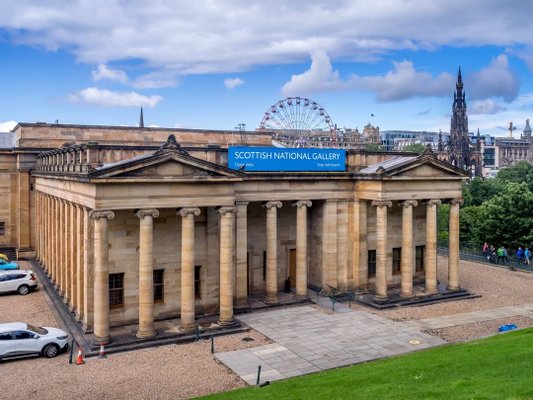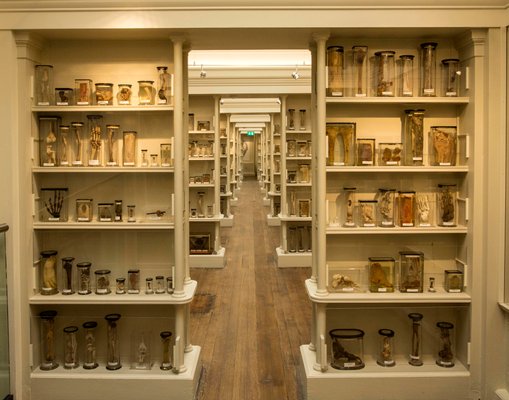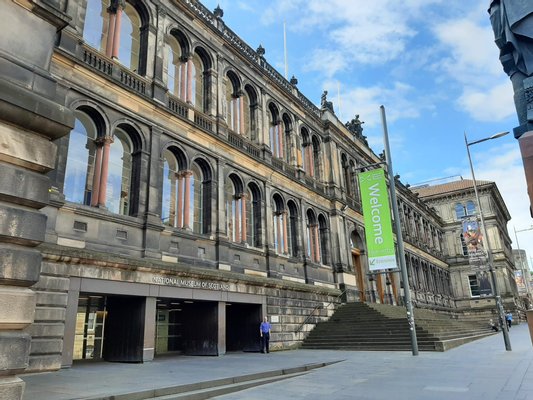Mentioned by Out About Scotland
Historic Buildings in Edinburgh - Complete Visitor Guide


"Address: Canongate, Royal Mile, Edinburgh, EH8 8BN, Scotland, UK Tel: +44 (0)131 226 5138 The Canongate Kirk is situated within the Old Town area of Edinburgh and is a particularly attractive building, being located just across from the Museum of Edinburgh and close to the university campus. This church serves as the place of worship for the Royal family when they are staying in the area and is steeped in history. Built in 1688, attractions include stunning architecture, classical music concerts and choir recitals."
"The modest Canongate Kirk was built in 1688 and completed three years later. It was founded for the residents of Canongate that had previously worshipped in the Abbey Church, until King James II converted the Church into a Chapel for the Order of the Thistle. Since the church is very bare, with practically no statues or paintings, the most eye-catching aspect of the temple is its blue benches on a maroon coloured carpet."

"Address: Lothian Road, Edinburgh, EH1 2EP, Scotland, UK Tel: +44 (0)131 229 1142 St. Cuthbert's stands alongside the West Princes Street Gardens and just up from the Royal Lyceum Theatre, where it was built on the remains of six previous historic churches. Visitors will be able to admire a stunning marble pulpit, colourful stained-glass windows, war memorials and an Italian Renaissance-style interior."
"St Cuthbert’s Parish Church, located at the west end of Princes Street, has several theories surrounding its origins. One is that St Cuthbert sheltered in a hollow below Castle Rock while journeying from Melrose. Whatever the true origin, this is the most ancient religious site in Edinburgh, although the present church building dates back to 1892-4."

"Roslin: Best known for being the home of Rosslyn Chapel, the church featured in Dan Brown’s ‘The Da Vinci Code,’ Roslin is a pretty village with plenty to see. Of course, there’s the ancient and ornate Chapel to visit, but there’s also castle ruins and a delightful tea room to enjoy a hot brew in."

"Address: 28 Manor Place / Palmerston Place, Edinburgh, EH12 5AW, Scotland, UK Tel: +44 (0)131 225 6293 Designed by George Gilbert Scott, the Cathedral Church of St. Mary the Virgin is located on the western side of the city centre. Construction of the cathedral began in 1874 and whilst the nave was opened just five years later, the twin spires on its western side were not actually completed until 1917. Highlights include impressive neo-Gothic architecture, well-preserved stained-glass windows, murals and an outstanding art collection, as well as daily choral services."
"St Mary’s Episcopal Cathedral is a short walk from Princes Street towards Haymarket. Its spires are visible from most places in Edinburgh, especially looking west from Princes Street. Not only does this cathedral offer a place of stillness in the bustling Scottish capital, there are also opportunities such as learning to be a stonemason in the Cathedral Workshop or a Cathedral Chorister at St Mary’s Music School."
"The neo-Gothic St. Mary's Cathedral is a striking building set in large grounds. Designed by George Gilbert Scott, it was consecrated in 1879. St. Mary's is the largest ecclesiastical building to be built in Scotland since the Reformation."

"Address: 61 York Place, Edinburgh, EH1 3JD, Scotland, UK Tel: +44 (0)131 556 1798 This popular Roman Catholic church dates back to 1814, being designed by James Gillespie Graham. Each month on the third Tuesday, look out for the organ and choir recitals. The adjacent Cafe Camino provides a rather tempting menu, offering bacon sandwiches, freshly made soup, lunchboxes for children, a choice of beverages (including coffee, tea, wine, beer and cider) and tubs of locally produced ice cream."
"St Mary’s Catholic Cathedral, originally called the Chapel of St Mary’s, held its first masses in August 1814. The Cathedral houses the National Shrine of St Andrew, Scotland’s patron saint, and even has an underground passage leading to a priest’s house in York Place. It wasn’t until the 1970s that passers by could see the Cathedral in its full splendor when tenements in front of the building were demolished."

"Also dating back to the 1800s, Old St Paul’s has since been renovated multiple times – the nave extended and the chancel floor raised with marble. Nearly all of the many panes of stained glass, ornaments and vestments were made possible by fundraising or donations. Unusually, the gargoyles at Old St Paul’s are located inside, not on the exterior of the church as is common on buildings of this period."

"Address: East London Street, Edinburgh, EH7 4BL, Scotland, UK Mansfield Place Church is to be found within the New Town area, standing close to the bus depot and the King George V Park. Built in 1872 by Robert Rowand Anderson, this old church has had many uses over the years and once even functioned as a nightclub. Today, it is owned by the Mansfield Traquair Trust, a conservation group who have actively restored the building over a number of years."

"The Scottish National Gallery of Modern Art is actually two institutions—Modern One and Modern Two—situated within two grand Georgian mansions flanking a sculpture park. Modern One has British artists like Francis Bacon, David Hockney, Damien Hirst, and Tracey Emin; American artists like Andy Warhol; and legends like Pablo Picasso and Henri Matisse. Modern Two has a particularly impressive Dada and Surrealism collection; you can arrange a private viewing of the archives, a real treasure trove of those movements."
"From Cubism and Expressionism to 20th-century Russian and French pieces, the Scottish National Gallery of Modern Art is unmissable for art buffs. With two early-19th-century buildings to explore (Modern One and Modern Two) and sweeping green spaces dotted with sculptures (including monumental earthworks by Charles Jencks), it’s well worth leaving the city centre to explore the galleries. Modern Two contains the intact studio of erstwhile Edinburgh sculptor Eduardo Paolozzi."



"This is one of Edinburgh's most popular modern attractions, especially for families. It tells the story of planet Earth from the Big Bang onward. It's among the newer kinds of child-centric science museums that focus on interactive experiences, and films rather than than dry exhibits."

"Royal College of Surgeons on Nicholson Street, Edinburgh, Scotland, UK.|© Duncan Hale-Sutton / Alamy Stock Photo. One for visitors with strong stomachs, the collections of the Surgeons’ Hall were started way back in 1699 and include all sorts of tortuous looking surgical and dental implements – the most perused exhibits are those relating to infamous Edinburgh grave robbers Burke and Hare. But it’s not all sensationalism – the museum also explores the city’s crucial role in the evolution of surgery and medicine."
"Getting to Surgeons Hall Museum : Located on Nicolson Street, the museum is a 9 minute walk from St Christopher’s Inns Edinburgh. The Surgeon’s Hall Museums are three museums rolled into one: the History of Surgery Museum, the Wohl Pathology Museum and the Dental Collection. The oldest artefacts inside these museums date back to 1699, however the building didn't open to the public until 1832 making this one of the oldest museums in Scotland."
"Nicolson Street, Edinburgh EH8 9DWOpen 10am to 5pm dailyAdult: £8, Students, NHS staff and children under 16: £4.50, unders 5's go free. If you are fascinated by the wonders of the human body, this museum is a must-visit. Owned by The Royal College of Surgeons of Edinburgh, Surgeons' Hall Museums consist of the Wohl Pathology Museum, the History of Surgery Museum and The Dental Collection."


"Visit the National Museum of Scotland or the National Gallery In the centre of the city, not far from one of the main great parks, you’ll find one of the best free things to do in Edinburgh in the form of the National Gallery. Filled with picturesque paintings and priceless artworks, it’s well worth a visit. Incredible works of art by artists such as Andy Warhol, Sir Henry Raeburn, and Robert Maplethorpe can all be found there."
"The diverse collection at the National Museum of Scotland encompasses the history of Scotland along with exhibitions of international interest. You can learn all about Scotland's past from the age of chivalry through to the industrial revolution and beyond. You'll also find diverse displays on everything from the pharaohs of ancient Egypt to the samurais of Japan."




